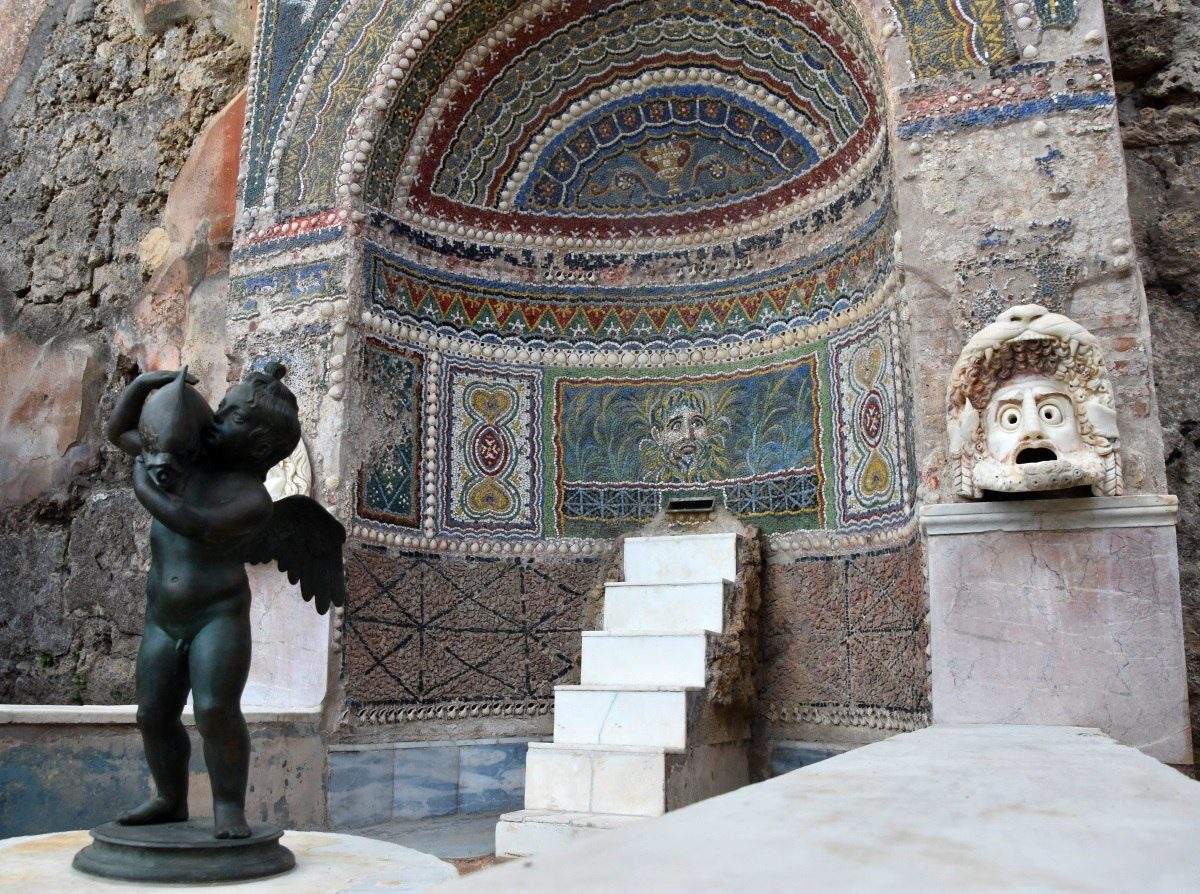Pompeii, House of the Great Fountain, House of the Anchor and Temple of Isis reopen after restorations
In Pompeii, the restoration works involving the House of the Great Fountain, the House of the Anchor and the Temple of Isis have been completed, and as of Friday, December 21, 2018, they reopen to the public, with the reintroduction of historical layouts, green decorating works and research investigations.
At the House of the Great Fountain, at the conclusion of restoration work, the historical layout of the fountain area is re-proposed, in line with the Museum spread project already experimented in various Pompeian domus, and with the relocation on site of the copy of the statue of puttino with dolphin. The original layout of the House of the Great Fountain dates back to the first half of the 2nd century B.C., but it was not until the 1st century A.D. that the large apse fountain covered with mosaics and shells and adorned with two marble theater masks, which gives the dwelling its name today, was leaned against the back wall. In the center of the fountain is a cylindrical base with a central hole, which at the time of its discovery, between 1826 and 1827, was devoid of decorative elements. Between the nineteenth and twentieth centuries the aforementioned copy of a cherub with dolphin discovered in 1880 in the garden of the House of the Arches was placed on the base at the center of the fountain: this arrangement, conceived perhaps in analogy with the nearby House of the Small Fountain, at the center of which is a statuette of a cherub with a goose, was later maintained for several decades during the twentieth century. The display presented today thus re-proposes that historical arrangement and thus restores the established image of the domus over the last century.
The Anchor House, with its original double-level floor plan, will exhibit the garden of the lower floor rearranged thanks to a restoration and maintenance of the greenery, according to a non-impactful design and a historical-botanical criterion in the choice of essences. The House is named after theanchor depicted in the entrance mosaic, a symbol of the tranquility and security that the dwelling offered to its inhabitants. It presents an absolutely original floor plan in the Pompeian panorama. In fact, the rear part is organized on two levels placed at different heights: the upper floor is centered around a large terrace overlooked by three large reception rooms, with floors decorated with mosaics of which the preparatory design is preserved in one case, while the lower floor is occupied by a garden, around which runs a covered portico with pillars. The dwelling underwent restoration of the decorative apparatus in 2015 as part of the Great Pompeii Project.
Finally, the Temple of Isis, in addition to general maintenance work and restoration of the decorative apparatus, was the subject of new archaeological investigations as part of the “excavations and research” project promoted by the Park. In particular, within the scope of one of the essays, traces of a sacrifice with both plant and animal offerings emerged, which made it possible to gain important insights into the rituals practiced in the sanctuary. The Temple of Isis was dedicated to the very ancient (mystery-type, i.e., reserved for initiates only) cult of the Egyptian goddess, which spread throughout the Mediterranean from the 3rd century B.C. for its message of hope in a life beyond death. According to myth, in fact, Isis recovered the parts of her bridegroom Osiris, who had been killed and dismembered by Seth, reassembled him and gave him back his life. In the center of a porticoed courtyard stands the temple on a high podium; in the space in front of it stand the altar, the offering pit and a small building(purgatorium) inside which a staircase leads to the basin from which to draw water, which was said to come directly from the Nile. Behind the temple a large hall was dedicated to initiate meetings(ekklesiasterion), while in a smaller one(sacrarium) paintings were visible that narrated episodes from the myth of the goddess. The decorative apparatus, sculptures and furnishings found in the sanctuary are on display at the National Archaeological Museum in Naples, but it is possible to partially relive the original effect thanks to the relocation in situ of some copies of frescoes and statues. In theekklesiasterion the visitor can, through multimedia apparatus, acquire information about the Isiac cult.
Pictured: the House of the Great Fountain
 |
| Pompeii, House of the Great Fountain, House of the Anchor and Temple of Isis reopen after restorations |
Warning: the translation into English of the original Italian article was created using automatic tools. We undertake to review all articles, but we do not guarantee the total absence of inaccuracies in the translation due to the program. You can find the original by clicking on the ITA button. If you find any mistake,please contact us.





























